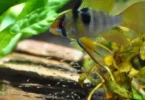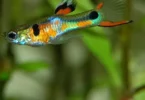Last Updated on April 23, 2023 by Coral Realm
In this article, we will be discussing the care needs of molly fish to ensure new tropical fish owners are educated on the correct care requirements, as well as giving experienced tropical fish owners new advice to increase their knowledge and ensure your mollies are healthy in their environment. This article will include information on a mollies diet, housing requirements, compatible tank mates, maintenance and much more.
IN THIS ARTICLE
Complete Molly Fish Care Guide
 Also known as short-finned molly or common molly, these tropical fish are one of the most commonly kept species by fish keeping enthusiasts. Mollies are freshwater fish that are usually seen in community tanks alongside compatible tank mates to create a beautiful aquarium, they come in a variety of colors with so many to choose from that there is one to suit everybody and are easy to care for due to their peaceful temperament, making them a great fish for beginners.
Also known as short-finned molly or common molly, these tropical fish are one of the most commonly kept species by fish keeping enthusiasts. Mollies are freshwater fish that are usually seen in community tanks alongside compatible tank mates to create a beautiful aquarium, they come in a variety of colors with so many to choose from that there is one to suit everybody and are easy to care for due to their peaceful temperament, making them a great fish for beginners.
Molly fish are known to live up to 5 years and once they hit adulthood, they can grow up to 4.5 inches, however they are usually much smaller. Mollies are omnivorous fish that will consume many different kinds of foods, and they will be more than happy to share their food with the other species in your tank.
Popular mollies that are kept in home aquariums include the Black Fish Molly that are black in color; the Sailfin Molly that come in a variety of colors and carry a large dorsal fin that starts from behind the head and ends at the caudal fin; and lastly the Lyretail Molly that stands out due to their large fins that are much longer than those of a common molly, as they trail behind them as they swim.
| Molly Fish Summary | |
| Family | Poeciliidae |
| Care level | Easy |
| Lifespan | Up to 5 years |
| Size | Up to 4.5 inches |
| Color | Various colors |
| Diet | Omnivores |
| Minimum tank size | 10 gallons |
| pH levels | 6.7 – 8.5 |
| Water hardness | 20-30 KH |
| Temperature range | 78 – 82 ℉ (25-27 ℃) |
| Compatibility | Other calm community fish |
| Tank set up | Fresh water tank with plants |
Housing:
One of the most important factors to consider when starting your tropical fish hobby, or adding mollies to your existing tank, is what environment they need in order to thrive and maintain their good health. As well as other community tropical fish, mollies need space to explore their enclosure and to escape the other tanks mates if there are any problems. Mollies are social and active so they thrive in schools. For mollies, this is usually 3 together in one tank as a minimum, however they will enjoy being in much larger groups of 10 or more.
A molly fish will need a 10 gallon tank, and every other molly in the same tank will need around 3 gallons on top of that; therefore if you have a group of 5 mollies in one enclosure (without any other species in the tank) they would need at least a 20 gallon tank as a minimum to suit their needs. You should always choose the larger option if any doubts occur when purchasing an enclosure, as mollies will thrive in a large space.
Larger tanks are also easier to maintain in the long term due to the slow production of algae compared to smaller tanks, meaning large tanks can be cleaned out less regularly. The ammonia levels in large aquariums also take much longer to rise than those in small tanks, meaning you will have time to notice and take action, whereas a smaller tank may mean that the fish are more likely to be harmed.

If you are a first time molly owner, you should take into account your intentions of keeping these fish when you purchase the tank. Mollies kept for general household pets should be kept in large aquariums where they can be housed with other mollies and other species in order for them to thrive.
The housing size requirements are different when breeding your mollies; they will be kept in a smaller aquarium that encourages the mollies to breed. Smaller tanks also gives the fry a more enclosed space to adapt to their new surroundings. This allows them to have access to their food without being bothered by other species or adult mollies. How to breed your mollies will be discussed later on in this article.
Mollies require a tank that contains substrate, plants, and hides for them to explore. The ideal is for them to live in a replica of their natural environment; the lack of such can cause stress which can then lead to diseases.
Water conditions and temperature

Mollies are tropical fish that are found in the shallow parts of rivers and streams throughout North and South America, the substrate found in these areas are sandy with pieces of rock and debris sitting on top; this environment should be replicated within your aquarium to suit their needs and allow your mollies to thrive. To ensure that your aquarium is safe for your mollies to live in the tank should be set up correctly with a correct water cycle so that harmful bacteria are converted into beneficial ones.
A tropical fish aquarium requires a filter, a heater, a light and a thermometer, the size and brand will depend on the size of your tank – aquariums under 50 gallons are more suited to internal filters or HOB filters whilst aquariums over 50 gallons are more suitable for external filters; for more information on equipment and to find the best equipment for you please see our other articles:
- Best Aquarium Heaters
- Best Aquarium LED Lighting
- 11 Best Aquarium Thermometers
These tropical fish require the water temperature to be between 78 and 82 degrees Fahrenheit (25 and 27 degrees Celsius). A heater should be installed to heat the water evenly to achieve this temperature; a heater will allow you to control the temperature and also ensure that the temperature is kept stable.
Major fluctuations in the temperature can cause problems to your fish as it will affect their metabolism and immunity; a sudden decrease in temperature can suppress their immune response whilst a sudden increase can cause stress. However it is usually better for the fish to be in warmer temperatures than cold.
All fish are unable to regulate their body temperatures and therefore rely on their surroundings to influence their body temperature – warm water increases their movement, metabolism and respiration; however, the water temperature for mollies should not exceed 82 degrees Fahrenheit.
Mollies can develop a disease known as “molly disease” that is caused by poor water conditions, which means it is vital that all molly owners take the correct steps to ensure that their mollies are living in the correct conditions to prevent diseases from occurring.
The water temperature can be monitored using a thermometer that can be placed at the front of the tank where it is easy to view, the thermometer should be placed away from the heater in order to pick up on the general water temperature and not where the warmest area is. The heater should warm the water up evenly to avoid any warm or cold patches throughout the tank. If this occurs, it may be due to using a heater that is too small for the size of your tank, and you may want to upgrade.
Mollies require a pH level of 6.7 – 8.5 and water hardness between 20-30 KH, this can be easily monitored by using chemical test trips or test kits around once a month or more depending on whether you are noticing any issues within the tank. See below for our recommended testers:
Aquarium test strips
These water test strips are a quick and easy alternative to the master test chemical kits, complete with four strips and a chemical chart. One of these strips is to be placed into the water for a short amount of time and the colors on the strip should then be compared to the color chart – this will then accurately tell you the levels of pH, nitrite, nitrate, carbonate and general water hardness.
Master test kit
This master kit is a more advanced alternative to the testing strips, with 7 bottles of testing solutions, 1 color card and 4 glass tubes. This kit will measure the pH, high range pH, ammonia, nitrite and nitrate, this kit may give you a more accurate result, however there is more of a risk of disrupting the process by putting too many or too little drops in the test tubes.
Feeding and diet
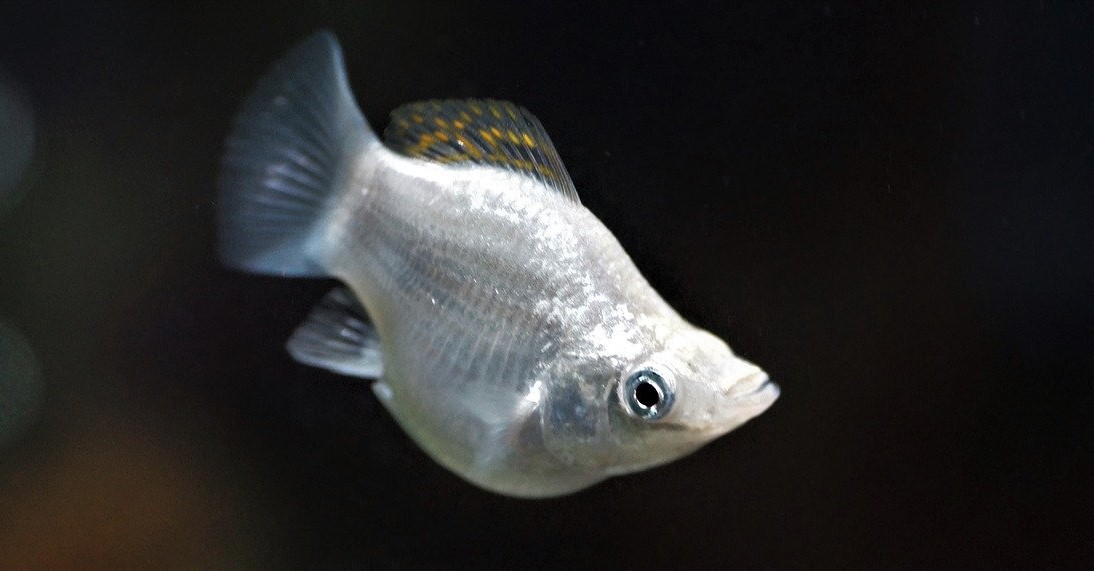
Mollies are omnivorous fish that feed on algae, plant matter and small invertebrates in the wild, therefore they should also be given a varied diet in a home aquarium including high quality flake food, pellets and occasional vegetables as a supplement. They should be fed 1-2 times a day and only fed as much as they can eat in 5 minutes, otherwise any leftover food will fall to the bottom and begin to rot. Molly fish should be given this variety of food in order to give them the necessary nutrients and ensure they are healthy. Mollies can also be fed live foods such as bloodworms and shrimps – these can be purchased at your local pet shop or online aquatic store.
Mollies are top feeders meaning that they usually consume their food at the top of the water column. However mollies are more adaptable that other species. As such you will often see them dwelling in the middle and bottom regions of the tank. This means that they will also consume any sinking pellets that go straight to the bottom of the tank.
Being top feeders, molly fish will feed on commercial floating flakes such as the tetra pro color flakes, these will float on the surface of the water for a while before beginning to sink. Mollies will also thrive off of sinking pellets and algae wafers.
Mollies can be fed vegetables including shelled peas, cucumber medallions and zucchini medallions, however this can sometimes be time consuming, therefore a spirulina-based flake or pellet can be an alternative to plant matter in their diet.
For more information on feeding your tropical fish you can read the following articles:
- Best foods to feed your tropical fish.
- Feeding tropical fish
Feeding techniques:
Mollies should be fed one to two times a day; in the morning and evening. They should only be fed as much as they can consume in five minutes. You should provide them with a variety of food types as leaning too much on one can lead to nutrient deficiencies.
When feeding your mollies their age needs to be taken into account; fry (new-born mollies) should be fed little and often; they benefit from flake food that has been broken down into tiny pieces. Adult mollies are able to consume all types of food such as flakes, crisps, pellets and other supplements like vegetables. Alternating between flake food, live food and vegetables will give them the most nutritious diet and will be the most beneficial way to keep them healthy and away from diseases.
Scatter feeding
Scatter feeding is so called as the food is spread around the aquarium. This allows the fish to catch and consume it by themselves. For mollies, these will be floating flakes, sinking pellets or wafers to allow them to consume the food anywhere in the tank.
Scatter feeding gives the fish a choice of food to consume as well as replicating their natural environment; in the wild they would consume small particles of food in the water. However, scatter feeding has a higher risk of contaminating the water than other strategies as the food will dissolve into the water if it is not eaten. This can result in not being able to physically see the rotting food; therefore diseases may occur as the aquarium may not be cleaned.
How to scatter feed:
- Purchase the desired food for that species
- Collect the food to feed the fish, for mollies an example of this would be the Tetra Pro Color flakes, brine shrimp or sinking pellets.
- Open the lid of the tank and put in 1-2 pinches of food into the water.
- Allow the mollies to consume the food and observe to ensure there are no fighting behaviors between the other species.
- Remove any excess food from the tank to prevent diseases and parasites, as well as to protect and maintain the quality of the water.
Drip feeding
Drip feeding involves a tube contraption that pours the liquid or dissolved food into the tank at a slow rate. While this does seem an unusual method, it is usually reserved for fry that requires food little and often in order to develop correctly. This method is effective when caring for fry as it allows you to have control over what they are consuming. Giving them large pellets or flakes makes it difficult for them to feed properly. As such they may not gain the essential nutrients that they need to grow.
How to use a drip feeder:
- Get a 1/16 inch tube to be inserted from the fish tank into the infusoria
- Mix the chosen food into the mixture and allow the tube to fill itself
- The mixture will drop into the water at around one drip per minute
Molly Fish Tank Mates
Molly fish are easy going and adaptable fish that are able to be house with many different species of fish. This is only if the tank is large enough as too many fish put into one small tank will cause the mollies to become aggressive towards the other fish; however, this will not occur if they are put in a large enclosure.
Mollies are social fish and like to be kept with other mollies in a school. So when getting a molly, you should think about getting more before adding in any other tank mates.
Mollies can be housed with top and middle dwellers and get on best with live bearers such as guppies, platys, swordtails and endler’s. These fish are similar to mollies and are also commonly kept species by tropical fish lovers; however, swordtails can cross breed with mollies whilst endler’s can cross breed with guppies, so if these species are to be housed together in one aquarium they should be monitored as unwanted breeding can occur.
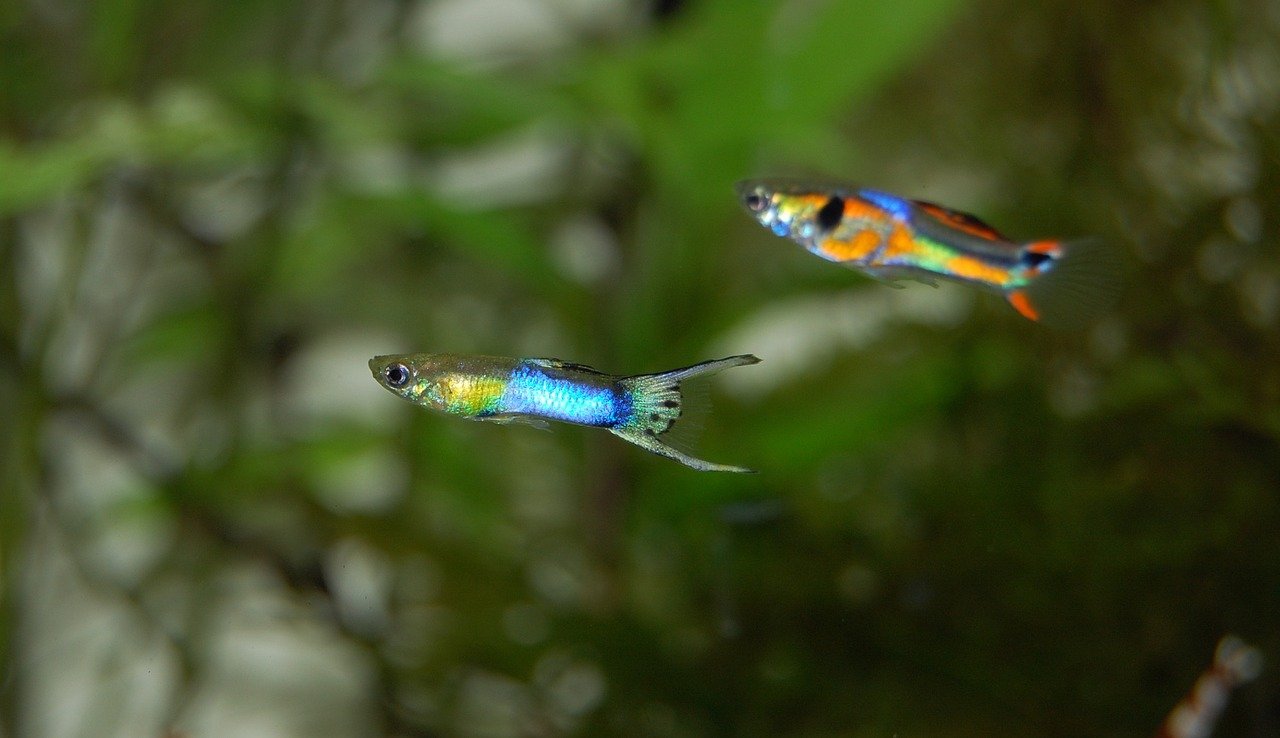
Guppies are perfect tank mates for Molly Fish
For this reason, the most ideal tank mates for mollies are bottom dwellers that find their food amongst the substrate. Mollies usually stay away from bottom dwellers as they can become protective over their food. This means that there will be no issue of bad interactions between the two species due to their differences. Molly fish are compatible with bottom dwellers such as shrimp, snails, Corydoras, loaches and plecos.
Mollies can also be housed with non-live bearers such as minnow fish, gourami fish, angel fish and betta fish. However, gourami fish can be aggressive towards mollies depending on their size, so a smaller gourami fish would be ideal to live with mollies, their aggression will also increase if the tank is too small. Male betta fish can also be aggressive, however female bettas are calm and are commonly seen to get lethargic if they are not housed with other fish, making them a good tank mate for mollies.
Fish that are large and have an aggressive reputation should be avoided as they may try to harm or eat your mollies. Cichlids are a group that contain some aggressive fish such as convict cichlids, so fish from this group should be thoroughly researched before putting them in with your mollies, however some cichlids such as angelfish aren’t aggressive and won’t be a problem to your mollies.
Enrichment
Like many other tropical community fish, molly fish are highly social and very inquisitive. As such they require forms of enrichment to keep their environment new and interesting in order to keep them happy and healthy.
It is important to have features in your aquarium such as hides, plants and food enrichment to allow them to exhibit their natural behaviors that would be seen in the wild. Enrichment will help your aquarium come to life as well as improving the state of your mollies, as well as any other species you are keeping. It will also keep your mollies in a good condition ready for breeding if that is your goal. This will also keep your mollies colors bright as it will improve their health.
Enrichment comes in different forms; it doesn’t always have to mean training your fish to swim through hoops or come when called; enrichment could simply be changing their food pattern or lighting. There are several methods of enrichment, these include:
Environmental enrichment – Changing the appearance or function of the aquarium for the fish to experience a new environment
Food enrichment – Using new foods to allow them to use different feeding methods
Social enrichment – Adding compatible species to the aquarium to give the fish company and new interactions
Environmental enrichment is one of the simplest ways to introduce enrichment to your fish. It can include slightly adjusting the lighting intensity every few days or depending on the season to give a different atmosphere. You can also mix things up with periodic changes to the exhibit such as putting in new logs, hides and plants to allow them to hide in new areas and experience different textures (this also prevents them from experiencing the same layout every single day).
There are some health and safety considerations when putting objects inside the aquarium. Firstly they should be big enough to prevent the fish from ingesting any decorations. They must also be strong and durable so that they don’t break and get ingested by accident. Care needs to be taken to ensure they do not contain any harmful chemicals that may contaminate the water. Lastly each and every item must be thoroughly washed before introducing them into the aquarium to remove any particles that may be on the items.
Here are some examples of what to include in your tank:
Logs and hides:
Invalid table id.
Artificial plants:
Invalid table id.
Live plants:
Live plants are great for enrichment for molly fish. Not only do live plants oxygenate the water and help to regulate the water chemistry they also provide a natural hideaway for molly fish.
There are many freshwater aquarium plants available for many different tank setups. All types of aquarium plant, floating, rooted, or carpeting, are suitable for mollies. Molly fish are top feeders, so if you do go for floating aquarium plants be sure that you maintain them and trim them back regularly so the fish can feed happily.
For more information on what aquarium plants you could get for your Mollies you can read the following articles we have:
12 Best Floating Aquarium Plants
Best Freshwater Aquarium Plants
Food enrichment
Food enrichment is a great way to stimulate different feeding methods that your mollies may use in the wild. This can include using live foods such as bloodworms, shrimp, fruit flies and mosquito larvae that will encourage their hunting abilities (these can be sourced from your local pet store or fish food provider); only put as many as your mollies can eat in one minute into the tank at once.
Whilst mollies can survive on commercial pellets and flake food, they are omnivorous animals and can also benefit nutritionally from fruit and vegetables. This is a great form of food enrichment as it will encourage them to forage for their food. Enhancing these natural foraging behaviors enables them to use their mouths in a different way. Rather than consuming floating foods they will need to peck at fruit and vegetables. These can be sliced into small pieces and placed into the tank in your preferred way; this can be attached to the glass, left to sink or held in place by the substrate.
Only feed fruit as a treat and up to twice a week as a maximum. Placing the food at the front of the tank is also a great way to encourage your mollies to swim in the open. Encouraging molly fish to leave their hiding spots is ideal for aesthetic purposes when using mollies for appearance reasons; you will get to see your fish out in the open more.
Breeding
Mollies are livebearers, meaning that eggs develop fully inside of their body and the fry will be born live and fully formed. Fry will immediately become independent and venture out on their own to find food. Mollies are one of the easiest fish to breed and will do so regularly if left alone. When attempting to breed mollies, their tank environment needs to be perfect and clean in order for the mollies to be comfortable as well as providing the best start to life for the newborn fry.
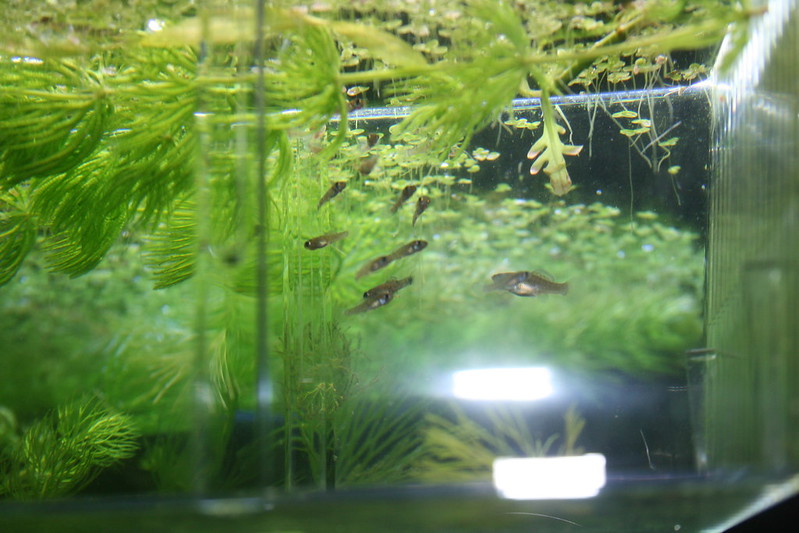
Molly fish fry in a planted breed tank. Credit: H080 (Flickr)
To initiate mating, raising the temperature of the water slightly can help the process; however, do not exceed 78 degrees Fahrenheit; as this could cause other issues. Female mollies will choose the largest male to mate with, and the male mollies perform a display to the females before mating, and the females (when ready to mate) will allow her eggs to be fertilized by the male. Occasionally, the male will approach the female from behind and attempt to fertilize the eggs without the female being aware, this can cause stress to the female and if this occurs regularly, you may have to replace the male with another.
It takes 35-45 days after fertilization for the fry to be released, and large females can release up to 100 live fry. Therefore, when breeding mollies the breeding tank needs to be large enough to accommodate all of the fry, however not too large to intimidate the female or the fry. If you don’t have access to a separate breeding tank, a breeding box will do the same job. This is placed into the tank with the pregnant female in, and when the fry are released they are pushed into a separate compartment of the box than the mother.
This is ideal as mollies are live bearers that have no connection to their fry and are known to eat their babies if left alone with them for too long. This can also be prevented by removing the mother from the fry as soon as they’re released. When the fry are big enough and have been fed enough times for them to hold the essential nutrients, they can be placed back into the tank.
Common health issues
Mollies are easy fish to care for and can survive in a range of conditions. However like all fish mollies can still pick up diseases or problems in their environment. The most common health issues seen in molly fish are White Spot Disease, fin and tail rot, velvet and molly disease.
See our articles on White Spot Disease and Fin Rot to find out more information on the causes and treatments.
Molly disease
“Molly disease”, also known as “livebearer disease” or “shimmies” occurs when the water condition is poor, as mollies are used to hard water conditions, when placed in soft water conditions it can cause this disease; this disease is seen in all livebearers, but is particularly common in mollies.
Shimmying is a symptom when the fish rocks its body from side to side. It can be caused by a number of factors including:
- Soft water – mollies are raised in brackish and hard water environments in the wild
- Low temperatures – this can cause the molly to physically shiver to attempt to raise its body temperatures
- Acidic, low pH – results in a burning sensation from the acidic water
- Low mineral levels – the fish’s kidneys can begin to shut down
If you notice your molly is shimmying, ensure that the water conditions are correct by using a chemical test strip or kit to test the levels in the water. If your aquarium has soft water, minerals can easily be assed with supplements, these include:
Crushed coral – crushed coral is a great way to raise the pH in your aquarium. It dissolves over time and the lower your pH level is, the faster it dissolves. Crushed coral also adds hardness to the water. It can be replaced every 1-2 years depending on how low the pH is in your water.
Seachem Equilibrium – Equilibrium is a mineral supplement used to harden the water and add minerals for livebearers such as mollies; they are also great for providing minerals for plants.
Wonder shell – these shells ass hardness to the water and also work as a dechlorinator, they also add a decorative look to your aquarium. A three pack will give you one shell per month.
Velvet disease
This disease is caused by Oodinium, a parasite that burrows into the fish’s skin. This causes small gold cysts that can spread extremely quickly. Action needs to be taken immediately in order to treat this disease.
Treatment:
- Copper medication can treat velvet slowly in the early stages, a great copper treatment is Seachem Cupramin.
- An alternative treatment is Fritz Aquatics Mardel CopperSafe Treatment, that treats ick, velvet and other external parasites.
- A major water change (70%-90%) is also necessary once the treatment has worked to avoid the parasites form returning
Are mollies the right fish for you?
Mollies are a great tropical fish for beginners due to their laid back attitude and easy care schedule. The range of colors they come in can add personality and life to your aquarium.
They also get along with a large variety of other fish and would be a great addition to your tank. Ensure you keep them in groups though. As they are also extremely simple and easy to breed, they can make a great addition for experienced fish owners or breeders.







